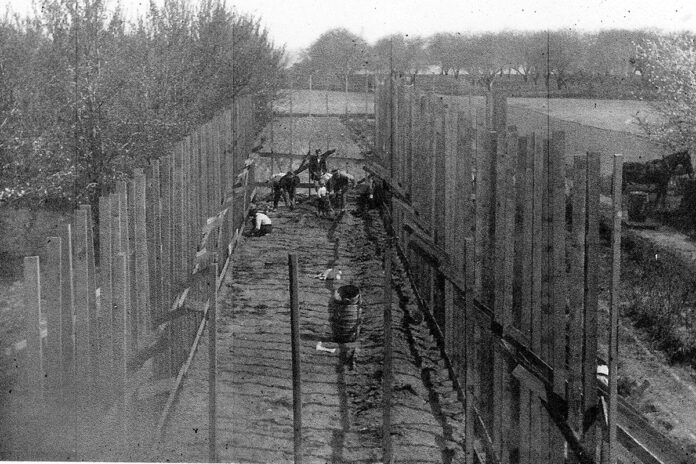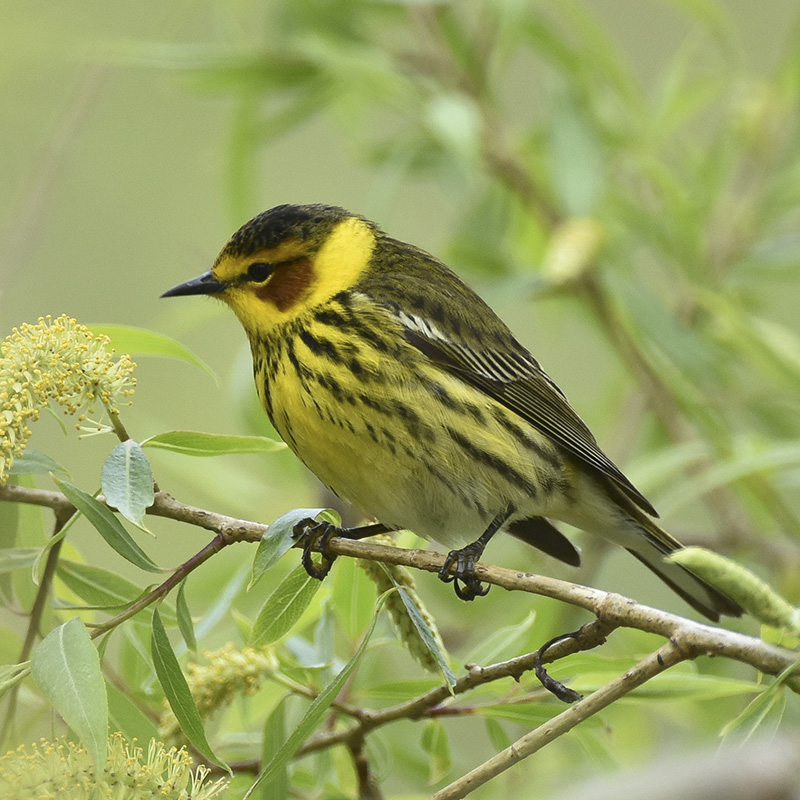
When Detroit industrialist Eber Brock Ward bought more than 4,000 acres of the Great Black Swamp in 1863, he opened that area on Lake Erie’s western shore to settlement and employment. The canal he built between Cedar Creek and the lake became the pathway to timbering, shipbuilding and milling operations and, later, to agriculture.
If he were to return to that area today, Ward would likely be shocked to see that much of the acreage he purchased is once again wetlands. And that visitors numbering in the tens of thousands come to parks and wildlife areas around the canal to watch migrating birds in April and May.
Festival
That includes the Biggest Week in American Birding festival, which is May 5-14 this year. The festival is hosted by the Black Swamp Bird Observatory, a nonprofit organization for research and conservation, located near Oak Harbor. But you can bet all the beaches, boardwalks and observation towers in Lucas and Ottawa counties will be crowded with people toting binoculars and telephoto lenses.
Deborah Herman-Miller spent three years researching the history of Ward’s Canal to try to get a historical marker placed there. Her efforts succeeded in 2021. The marker is where a path in the Howard Marsh Metropark meets the canal.
Though she now lives in Portage County’s Freedom Township, the retired educator grew up on a farm not far from the canal, where her brother and other kids from the little town of Bono used to ice skate and fish.
“Growing up, it seemed like kids living in the area didn’t know the history of the canal or appreciate it,” Herman-Miller said. “They just just thought of it as a big ditch.“
Canal
The land Ward purchased teemed with oak, walnut, ash and elm trees. He would need a way to get products and materials in and out, so he built a canal 2 3/4 mile long and 15 feet deep in 1870. Though he brought a steam dredger from Detroit, much of the work was done by men with picks and shovels.
Ward then built a sawmill and a shipyard that produced barges, steamships, schooners and tugboats. Timber was a primary ingredient in shipbuilding. One steamer named Music had 75 first-class cabins constructed of black walnut. The shipyard operated until 1875, the same year Ward died suddenly of a heart attack.
Around 1900, George Howard bought nearly 1,500 acres of Ward’s property, including the canal. Using what he’d learned visiting Holland, he drained the acreage to create an onion farm, continuing to use the canal for water control.
Later, settlers on the other side of the canal used a dike, drainage canals and a fancy water-lifting elevator to create the Metzer vegetable farms. They operated until high water damaged the dike in 1929. The dike was not rebuilt and the land reverted to marsh.
Before settlers arrived, the Black Swamp covered almost a million acres on the southern shore of Lake Erie, including 300,000 acres of coastal wetland.
“Today, 30,000 acres of those coastal wetlands remain while only fragmented pieces of the Great Black Swamp still exist,” said Kelly Schott, wildlife communications specialist for the Ohio Division of Wildlife.
A swamp is basically flooded woodlands, and timbering took all but 10 to 15% of the Black Swamp’s trees, she said. A muck fire that burned for three months in 1895 destroyed most of the trees that remained.
Around the turn of the century, people began to be concerned about the disappearance of species. It wasn’t only from loss of habitat through deforestation and drainage, but unregulated market hunting. Uncounted carcasses of animals, fish and even birds like the now-extinct passenger pigeon were sold in other areas of Ohio and across state lines. Fish populations also collapsed as rivers and streams became muddy, and the wetlands were no longer there to prevent runoff into the lake.
“Individuals started sounding the alarm, many of them duck hunters,” Schott said.
Hunting clubs — including the Winous Point and Ottawa shooting clubs, two of the oldest clubs in North America — began restoring wetlands and managing them for conservation. In the early 1900s, countless clubs existed in Lucas and Ottawa counties as hunters were willing to pay a premium to use these areas. But for many of these clubs, membership dues were not enough to keep up with the expense of maintaining the dikes and ditches for water control.
The division of wildlife, now celebrating its 150th anniversary, stepped in when some of those clubs went under, Schott said. Funded with money from hunting and fishing licenses and sales of hunting equipment, the state agency was able to purchase the former farmland on the east side of the canal, which is now a 900-acre wetland called Metzger Marsh Wildlife Area.
In 2008, Metroparks Toledo purchased 1,000 acres on the west side of the canal for Howard Marsh Metropark. Farming was allowed on the land until 2015, then reconstruction of wetlands began. The pump structure used for water control in Howard Marsh is on Ward’s Canal.
Grand re-opening
Similar purchases led to Maumee Bay State Park, Ottawa National Wildlife Refuge and Magee Marsh Wildlife Area where Schott has been working on the renovation of the visitor center that will have its “grand re-opening” May 4. Some hunting clubs remain, but dozens of parks, nature preserves and wildlife areas run by government or private agencies now dot the counties around the canal.

The H2Ohio program that Ohio Gov. Mike DeWine and the Ohio Department of Natural Resources launched in 2019 is aimed at improving water quality. That includes creating and restoring wetlands, which filter pollutants and prevent runoff of nutrients like phosphate and nitrogen that lead to algal blooms. The program originally focused on the Maumee Bay area of Lake Erie, but now extends to the Ohio River.
DeWine’s office and the ODNR recently announced two new coastal wetlands programs in the Sandusky Bay area southeast of the canal. In one project, 44 acres of wetlands in the Pickerel Creek Wildlife Area will be restored, connecting the creek to its floodplain. This will allow sediments and nutrients to settle so fewer will make it into the bay.
The Raccoon Creek project will restore shoreline wetlands and promote aquatic vegetation. This is not only to improve Lake Erie’s water quality, but to provide spawning areas for popular game fish like the northern pike, and more places for birds to forage and nest.
The work done to restore wetlands in the last century and this one has not only resulted in the return of many animal, fish and bird species that had disappeared, but also a veritable population explosion of both migrating and resident birds. The Cornell Lab of Ornithology’s tracking programs have recorded more than 300 bird species in the area during peak migration periods from mid-April to late May.
Those 300 species include 36 species of warblers, which is why this area of Northwest Ohio has been dubbed the Warbler Capital of the World. So it’s no wonder that the count of human visitors to the area – coming from all 50 states and foreign countries – has neared 90,000 some years.
The area is at the junction of two major migration routes for birds called neotropical migrants. They may come from the southern United States, or as far south as Central or South America. Some will continue to fly to points north, ranging from Newfoundland to the Yukon.

Crossing the lake
But flying across Lake Erie is a bit intimidating, so many of the migrating birds stop on Lake Erie’s south shore before proceeding. Magee Marsh has a 40-acre patch of forest along the boardwalk where they can rest. And the wetlands provide plenty of seeds and insects, like caterpillars and midges, to fortify them on their way.
However, not all the migrants choose to cross the lake; some stay and nest. The diversity of the wetland habitats, providing both shallow and deeper water, provide nesting areas for many species including sandhill cranes, mallards, wood ducks, Virginia rails and trumpeter swans. And some of the birds those 90,000 visitors are watching may be permanent residents of Ohio.
Aside from being in the heart of the wetland restoration and birding action, Ward’s Canal is home to Meinke Marina and Cooley Canal Yacht Club, both of which use the canal for access to Lake Erie. There are also places to fish and birdwatch along the canal’s shores.
Herman-Miller is proud to have brought some recognition to the history of Ward’s Canal, but also to be part of today’s conservation efforts. After being farmed by four generations, her family’s land across from Metzger Marsh and the Ottawa National Wildlife Refuge is now officially the John E. Herman Wetland Restoration Area.
“The Black Swamp was the last area in Ohio to be settled, and Ward’s Canal facilitated that settlement,” she said. “I didn’t want that history to be lost.”











Cool story. I live in utah but grew up in ohio. Thanks for your efforts to educate and illuminste our history and its link to our present.
Very good !